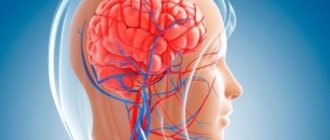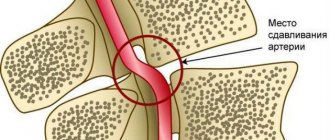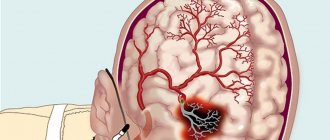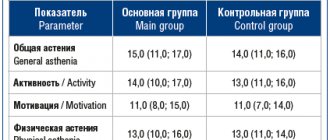Synonyms:
- encephalopathy,
- chronic cerebral ischemia,
- slowly progressive cerebrovascular accident,
- chronic ischemic brain disease,
- cerebrovascular insufficiency,
- vascular encephalopathy,
- atherosclerotic encephalopathy,
- hypertensive encephalopathy,
- atherosclerotic angioencephalopathy,
- vascular (atherosclerotic) parkinsonism,
- vascular (late) epilepsy,
- vascular dementia.
The most widely used term in domestic neurological practice is “dyscirculatory encephalopathy ,” which retains its meaning to this day.
Chronic venous insufficiency - symptoms and treatment
There are many ways to treat CVI. In specialized clinics, the main focus is on minimally invasive treatment methods, that is, surgical interventions with minimal damage to the skin.
Endovasal laser coagulation (EVLC)
In developed countries, up to 40% of patients suffering from this disease receive assistance using laser technology. With early diagnosis, treatment takes little time and leaves no traces. Many clinics use a phlebological water laser with a wavelength of up to 1500 nm, supporting radial light guides. This technology allows you to close veins of any diameter through a small puncture of the skin.
Sclerotherapy
The sclerotherapy method is based on the introduction of a sclerosant into the lumen of the affected vessel. Thanks to this substance, the vein becomes overgrown and subsequently disappears completely. For deeper location of varicose veins, the echo sclerotherapy technique is used. For more accurate intravenous administration of the drug, the procedure is performed under ultrasound control. With this technique, replacement occurs with connective tissue, which disappears within a few months. Sclerotherapy is also used to eliminate the external cosmetic manifestations of varicose veins.
The technique of diode fluorescent sclerotherapy consists of illuminating telangiectasia (up to 0.4 mm) or reticular veins (up to 2 mm) with a fluorescent lamp, into the lumen of which a special solution is injected.
A promising direction in aesthetic phlebology is the combined use of diode laser and sclerotherapy - laser cryotherapy (ClaCS). This method allows you to eliminate reticular veins and telangiectasias without any particular discomfort.
Conservative therapy for CVI consists of:
- taking phlebotonic drugs, which improve the rheological properties of the blood and maintain the tone of the veins;
- eliminating factors for the occurrence of CVI (reducing the body weight of patients, increasing physical activity, etc.);
- wearing compression stockings.[4][6]
The patient should not worry about choosing a treatment method, since the phlebologist will select an individual treatment option depending on the patient’s age and type of activity, the form of his disease and the presence of pathologies. Usually, when visiting large phlebology centers, specialists simultaneously use many methods to treat one patient. For example, for the most effective and efficient treatment of CVI, laser surgery is performed in combination with injection methods for treating veins.[4]
Causes of chronic cerebrovascular insufficiency:
Basic:
- atherosclerosis;
- arterial hypertension.
Additional:
- heart disease with signs of chronic circulatory failure;
- heart rhythm disturbances;
- vascular abnormalities, hereditary angiopathy;
- venous pathology;
- vascular compression;
- arterial hypotension;
- cerebral amyloidosis;
- diabetes;
- vasculitis;
- blood diseases.
For adequate brain function, a high level of blood supply is required. The brain, whose mass is 2.0-2.5% of body weight, consumes 20% of the blood circulating in the body. The value of cerebral blood flow in the hemispheres is 50 ml per 100 grams per minute, glucose consumption is 30 µmol per 100 grams per minute, and in gray matter these values are 3-4 times higher than in white matter. Under resting conditions, the brain's oxygen consumption is 4 ml per 100 grams per minute, which corresponds to 20% of the total oxygen entering the body. With age and in the presence of pathological changes, the amount of cerebral blood flow decreases, which plays a decisive role in the development and increase of chronic cerebral circulatory failure.
The presence of headaches, dizziness, memory loss, sleep disturbances, the appearance of noise in the head, ringing in the ears, blurred vision, general weakness, increased fatigue, decreased performance and emotional lability - these symptoms most often simply “inform” a person about fatigue. Only when the vascular genesis of the “asthenic syndrome” is confirmed and focal neurological symptoms are identified, a diagnosis of “dyscirculatory encephalopathy” is made.
The basis of the clinical picture of discirculatory encephalopathy is currently recognized as cognitive impairment . In case of chronic cerebrovascular accident, it should be noted that there is an inverse relationship between the presence of complaints, especially those reflecting the ability to cognitive activity (memory, attention), and the severity of chronic failure: the more cognitive functions suffer, the fewer complaints. In parallel, emotional disorders develop (emotional lability, inertia, lack of emotional response, loss of interests), various “motor disorders” (disorders of walking and balance).
Vertebro-basilar insufficiency: causes, symptoms, treatment
The disease is characterized by repeated attacks of reversible ischemia of brain cells (local decrease in blood supply), as a result of which they do not receive the necessary nutrition.
Ischemic attacks (or small strokes of the vertebrobasilar system) have an increasing etiology of neurological deficit and gradually lead to dysfunction of the central nervous system (CNS).
Most often, vertebrobasilar insufficiency is observed in patients suffering from symptoms of cervical osteochondrosis. The disease can develop in people of different age categories. In the early stages, VBI is completely reversible; in an advanced state, there is a high probability of strokes.
Anatomy
Paired vertebral arteries emerge from the subclavian arteries, located in the upper part of the chest, pass through the openings of the transverse processes of the cervical vertebrae, then through a larger opening into the cranial cavity. At this point, the vertebral beds merge into a single basilar artery, which is based in the lower parts of the brain stem.
The branches extending from the basilar artery wash and supply oxygen and nutrients to the cerebellum, pons, occipital lobes of both hemispheres of the brain, medulla oblongata and other parts. A decrease in blood flow in the vertebral and basilar vessels initially provokes temporary disorders (dizziness, motor dysfunction, loss of coordination of movements and spatial orientation, headaches), a complete cessation of blood circulation provokes necrosis of a certain area of the brain or a stroke.
Causes of the disease
The main reason for the formation of vertebrobasilar insufficiency is a violation of the patency of blood channels (stenosis). Most often, the areas of direct entry into bone canals or the place where arteries merge into one are susceptible to narrowing of the lumen of blood vessels. In addition, the culprits in the development of the disease may be atherosclerotic formations in the vessels, congenital anomalies in the development of the vascular bed, or inflammatory diseases of the vascular system.
The progression of VBI is significantly influenced by growing vertebral bone formations (osteophytes), treatment of spinal spondylosis and/or spondyloarthrosis in older people. The most common causes of deficiency:
- traumatic injuries of the cervical spine;
- thrombosis and thrombophlebitis of blood vessels;
- compression of the vertebral or basilar arteries by displaced vertebrae (spondylolisthesis) or cervical intervertebral hernia, which is not treated;
- damage to small vessels of the brain caused by diabetes mellitus;
- hypertension (high blood pressure);
- fibromuscular dysplasia, spasm of the neck muscles, or vice versa – hypertrophy of the scalene muscle, which impinges on the blood vessels.
Clinical manifestations of VBI
The development of failure is manifested by various neurological symptoms, usually combined, the degree and severity of which depends on the size and location of ischemic foci.
Main manifestations of the disease:
- dizziness, fainting, nausea, vomiting, loss of orientation, balance, are associated with insufficient blood supply to the part of the brain responsible for the vestibular apparatus;
- impairment of the functions of the organs of hearing and vision (tinnitus, flickering of flies or diverging circles, darkening of the eyes, the appearance of rotation of surrounding objects, their bifurcation or blurred contours);
- speech and swallowing disorders (hoarseness, soreness or sensation of a lump in the throat);
- absent-mindedness, memory impairment, poor concentration, fatigue of the body, weakness in the limbs;
- emotional outbursts (sharp changes in mood), autonomic hot flashes (unexpected sweating, feeling of heat in the face or head, rapid heartbeat, surges in blood pressure);
- throbbing, pulling or burning headaches, the treatment of which is difficult, localized in the back of the head.
Diagnosis of the disease
Clinical manifestations of vertebrobasilar insufficiency do not have specific manifestations and may be similar to the symptoms of other diseases. Thus, to establish an accurate diagnosis, a thorough examination of the patient’s complaints, instrumental studies, clinical and laboratory tests is required.
The main method for diagnosing VBI is Doppler ultrasound or duplex scanning of the arteries and vessels of the brain and neck. The methods are based on studying the speed of passage of blood fluid along the bed, are absolutely painless and safe.
Magnetic resonance imaging of the brain allows us to identify foci of previous ischemic attacks, scars, heart attacks, lesions of the brain matter, etc. X-ray images of the cervical spine will show pathological changes in the structures, the presence of hernias, displacements, compressions.
A highly informative method for determining the causes of failure is angiography. Allows you to examine the condition of the walls and lumens of small vessels. Consists of a series of x-rays taken after the patient has been given a contrast dye.
Treatment of vertebrobasilar insufficiency
The initial stages of the disease respond well to treatment on an outpatient basis. In the presence of acute neurological manifestations, persistent stenosis or thrombosis of arterial lines, treatment is recommended in a hospital to prevent the formation of strokes.
The attending physician prescribes complex therapy consisting of medications and physical therapy. At the same time, no general treatment can be distinguished, since each clinical case is considered separately and prescriptions are made individually.
The general advice of specialists can only be to exclude factors that provoke ischemic attacks and affect the condition of the blood vessels of the brain (limiting alcohol consumption and quitting smoking, normalizing body weight, proper rest and nutrition, adequate physical activity, active lifestyle).
Drug therapy usually consists of vasodilators (vasodilators), substances that reduce blood clotting (anticoagulants and antiplatelet agents). To improve blood circulation in the brain and restore affected areas, metabolic and nootropic drugs are used. An indispensable natural remedy in this group are medicines containing extract of the Ginkgo Biloba plant. If necessary, substances are prescribed to control the normal state of blood pressure.
Physiotherapeutic measures consist of:
- general or therapeutic massage (improves blood circulation in pathological areas);
- Exercise therapy (strengthens the muscle corset of the neck, helps relieve spasms, improves the general condition of the body);
- yoga (gently stretches and works deep muscles);
- manual therapy sessions (acupuncture, reflexology, relaxation therapy, plantar massage by Dr. Bobyr);
- wearing a cervical brace (stabilization of the spine in the treatment of spondylolisthesis);
- hirudotherapy or treatment with leeches (effective in treating blood vessels).
Surgical treatment of vertebrobasilar insufficiency is considered only as a last resort and is offered to a fairly small number of patients. The purpose of surgical intervention is to eliminate the lack of blood supply to the brain associated with a decrease in the lumen of blood vessels (stenosis), compression of the arteries by bone structures, intervertebral hernias or spasmed muscles.
Types of operations:
- Vascular angioplasty, in which a special stent is installed in the artery, preventing the lumen from narrowing or blocking the passage opening, allowing the vessels to maintain normal throughput;
- endarectomy - removal of atherosclerotic plaques with part of the internal inflamed wall of the vessel;
- microdiscectomy – removal of part of the intervertebral disc and/or disc herniation with subsequent implantation of stabilization systems or without them.
Author: K.M.N., Academician of the Russian Academy of Medical Sciences M.A. Bobyr




![Rice. 1. Functioning of the glymphatic system of the brain (according to [11]) 1. Glymphatic system functioning (according to [11])](https://expert35.ru/wp-content/uploads/ris-1-funkcionirovanie-glimfaticheskoj-sistemy-mozga-po-11-fig-1-330x140.jpg)





